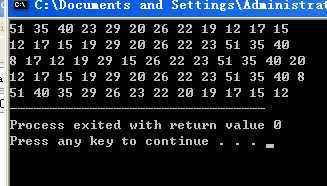STL里面的堆操作一般用到的只有4个:make_heap();、pop_heap();、push_heap();、sort_heap();
他们的头文件函数是#include
<algorithm>
首先是make_heap();
他的函数原型是:void
make_heap(first_pointer,end_pointer,compare_function);
一个参数是数组或向量的头指针,第二个向量是尾指针。第三个参数是比较函数的名字。在缺省的时候,默认是大跟堆。(下面的参数都一样就不解释了)
作用:把这一段的数组或向量做成一个堆的结构。范围是(first,last)
然后是pop_heap();
它的函数原型是:void
pop_heap(first_pointer,end_pointer,compare_function);
作用:pop_heap()不是真的把最大(最小)的元素从堆中弹出来。而是重新排序堆。它
把first和last交换,然后将[first,last-1)的数据再做成一个堆。
接着是push_heap()
void
pushheap(first_pointer,end_pointer,compare_function);
作用:push_heap()假设由[first,last-1)是一个有效的堆,然后,再把堆中的新元素加
进来,做成一个堆。
最后是sort_heap()void
sort_heap(first_pointer,end_pointer,compare_function);
作用是sort_heap对[first,last)中的序列进行排序。它假设这个序列是有效堆。(当然
,经过排序之后就不是一个有效堆了)
下面是例程:
#include<algorithm>
#include<cstdio>
using
namespace std;
bool cmp(int a,int b)
{
return
a>b;
}
int main()
{
int
i,number[20]={29,23,20,22,17,15,26,51,19,12,35,40};
make_heap(&number[0],&number[12]);
for(i=0;i<12;i++)
printf("%d
",number[i]);
printf("\n");
make_heap(&number[0],&number[12],cmp);
for(i=0;i<12;i++)
printf("%d
",number[i]);
printf("\n");
//加入元素8
number[12]=8;
//加入后调整
push_heap(&number[0],&number[13],cmp);
for(i=0;i<13;i++)
printf("%d
",number[i]);
printf("\n");
//弹出元素8
pop_heap(&number[0],&number[13],cmp);
for(i=0;i<13;i++)
printf("%d
",number[i]);
printf("\n");
sort_heap(&number[0],&number[12],cmp);
//结果不用说都知道是有序的了!
for(i=0;i<12;i++)
printf("%d
",number[i]);
return 0;
}
- #include <cstdio>
- #include <vector>
- #include <algorithm>
- #include <functional>
- using namespace std;
- void PrintfVectorInt(vector<int> &vet)
- {
- for (vector<int>::iterator pos = vet.begin(); pos != vet.end(); pos++)
- printf("%d ", *pos);
- putchar(‘\n‘);
- }
- int main()
- {
- const int MAXN = 20;
- int a[MAXN];
- int i;
- for (i = 0; i < MAXN; ++i)
- a[i] = rand() % (MAXN * 2);
- //动态申请vector 并对vector建堆
- vector<int> *pvet = new vector<int>(40);
- pvet->assign(a, a + MAXN);
- //建堆
- make_heap(pvet->begin(), pvet->end());
- PrintfVectorInt(*pvet);
- //加入新数据 先在容器中加入,再调用push_heap()
- pvet->push_back(25);
- push_heap(pvet->begin(), pvet->end());
- PrintfVectorInt(*pvet);
- //删除数据 要先调用pop_heap(),再在容器中删除
- pop_heap(pvet->begin(), pvet->end());
- pvet->pop_back();
- pop_heap(pvet->begin(), pvet->end());
- pvet->pop_back();
- PrintfVectorInt(*pvet);
- //堆排序
- sort_heap(pvet->begin(), pvet->end());
- PrintfVectorInt(*pvet);
- delete pvet;
- return 0;
- }
